|
|
Progress of Ultra-high Temperature Oxide Ceramics: Laser Additive Manufacturing and Microstructure Evolution
CHEN Qian, SU Haijun, JIANG Hao, SHEN Zhonglin, YU Minghui, ZHANG Zhuo
2024 Vol. 39 (7): 741–753
 Abstract
Abstract(
310 )
 HTML
HTML(
24)
 PDF
PDF(3835KB)(
382
)
Oxide ceramics, known for their outstanding strength and excellent oxidation and corrosion resistance, are prime candidates for high-temperature structural materials of aero-engines. These materials hold vast potential for application in high-end equipment fields of the aerospace industry. Compared with traditional ceramic preparation methods, laser additive manufacturing (LAM) can directly realize the integrated forming from raw powders to high-performance components in one step. LAM stands out for its high forming efficiency and good flexibility, enabling rapid production of large complex structural components with high performance and high precision. Recently, research on LAM for melt-grown oxide ceramics, which involves liquid-solid phase transition, has surged as a hot topic. This paper begins by outlining the basic principles of LAM technology, with an emphasis on the process characteristics of two typical LAM technologies: selective laser melting and laser directed energy deposition. On this basis, the paper summarizes the microstructure characteristics of several different oxide ceramics prepared by LAM and examines how process parameters influence these microstructures. The differences in mechanical properties of laser additive manufactured oxide ceramics with different systems are also summarized. Finally, the existing problems in this field are sorted out and analyzed, and the future development trend is prospected.
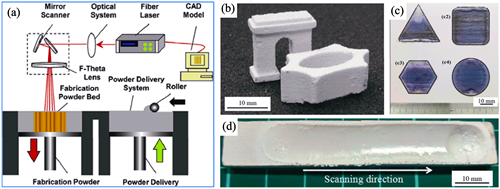
|
|
|
Effect of Particle Grading on Properties of Silicon Carbide Ceramics Prepared by Selective Laser Sintering Printing Combined with Solid-phase Sintering at Atmospheric Pressure
WANG Kanglong, YIN Jie, CHEN Xiao, WANG Li, LIU Xuejian, HUANG Zhengren
2024 Vol. 39 (7): 754–760
 Abstract
Abstract(
166 )
 HTML
HTML(
12)
 PDF
PDF(18947KB)(
240
)
Silicon carbide (SiC) ceramics are widely used in critical industries such as aerospace, nuclear energy, chemical processing, and semiconductor manufacturing due to their unique thermal and electrical properties coupled with excellent mechanical properties. Nevertheless, conventional forming methods often fall short when it comes to producing large-sized and complex components. Selective laser sintering (SLS) printing has the advantages of no support, high material utilization, high processing efficiency, etc., endowing it suitable for the precise fabrication of ceramic structural components with complicated shape. Here, the particle grading approach was employed to systematically investigate the impacts of processes such as cold isostatic pressing (CIP), precursor impregnation pyrolysis (PIP), and the combination of CIP with PIP followed by solid-phase sintering at atmospheric pressure. The results revealed that the graded powders significantly enhanced both the bulk density and the flexural strength of the formed body by over 20% compared to non-graded systems. Relative density of the graded system after CIP and subsequent solid-phase sintering at atmospheric pressure was over 90%, confirming successful densification during sintering. In contrast, the non-graded sintered body only achieved a density of 89%. Implementation of the particle grading led to an increase in bulk density, and it was beneficial for achieving higher densification during sintering. Consequently, the flexural strength of the grading-sintered body was significantly improved, reaching 136.8 MPa—a gain of over 37% compared to the non-graded counterpart whose flexural strength was only 99.4 MPa. Meanwhile, high-density SiC ceramics could be achieved by repeating PIP for four cycles combined with solid-phase sintering of which SiC ceramics density was comparable to that of CIP compacts. However, the bulk density of solid-phase sintered body after four PIP cycles was only 2.29 g/cm3, which was accompanied by a flexural strength of 59.6 MPa.

|
|
|
First-principles Study on Mechanical Properties and Melting Curve of HfxTa1-xC System
WU Yuhao, PENG Renci, CHENG Chunyu, YANG Li, ZHOU Yichun
2024 Vol. 39 (7): 761–768
 Abstract
Abstract(
216 )
 HTML
HTML(
8)
 PDF
PDF(3195KB)(
217
)
HfxTa1-xC is a very promising candidate for thermal protection materials above 2000 ℃ due to its excellent properties such as high melting point, high hardness, high strength, high electrical conductivity, and high thermal conductivity. However, the rules of its mechanical properties and melting temperature varying with the composition remain elusive. Firstly, the mechanism of the variation of mechanical properties of HfxTa1-xC system solid solutions with its components was systematically investigated from the microscopic point of view of covalent bond strength and valence electron concentration (VEC) based on the special quasirandom structures (SQS) method and first-principles calculations. It revealed that among the five components of solid solutions (i.e., HfC, Hf0.75Ta0.25C, Hf0.5Ta0.5C, Hf0.25Ta0.75C and TaC), the Hf0.25Ta0.75C solid solution possessed the largest elastic modulus and shear modulus. It was mainly attributed to two reasons: (1) the component possessing the strongest covalent bonding strength among the above ternary compounds; (2) the special bonding states between the p-orbital from C and the d-orbital from Hf or Ta strongly resisting the deformation and being completely filled near VEC=8.75 (for Hf0.25Ta0.75C). Secondly, the melting curves of the HfxTa1-xC system solid solutions were calculated using the ab initio molecular dynamics (AIMD)-based molecular dynamics Z method. It showed that there existed indeed the phenomenon for anomalous increase in the melting temprature of HfxTa1-xC system solid solutions, and the highest melting temperature of 4270 K was predicted on Hf0.5Ta0.5C, which was mainly attributed to the synergistic effect of the conformational entropy and the strength of the covalent bond. The results provide a theoretical guidance for the experimental selection of the optimal components of high melting temprature and high mechanical properties for HfxTa1-xC system solid solutions in the thermal barrier coating applications, as well as a reference for the study of other transition metal carbides.
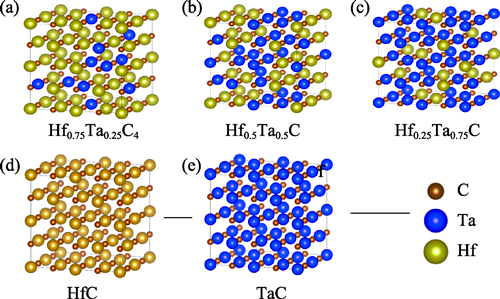
|
|
|
Textured Porous Al2O3-SiO2 Composite Ceramic Platelet-sphere Slurry: Characteristics and Simulation of Light Intensity Distribution
WU Xiangquan, TENG Jiachen, JI Xiangxu, HAO Yubo, ZHANG Zhongming, XU Chunjie
2024 Vol. 39 (7): 769–778
 Abstract
Abstract(
153 )
 HTML
HTML(
9)
 PDF
PDF(6626KB)(
178
)
Ceramic stereolithography has a broad prospect in preparation of Al2O3-SiO2 composite ceramics through which the prepared textured Al2O3-SiO2 composite still faces challenges in improving their slurry quality and light intensity distribution. Here, characteristics of a novel ceramic slurry with addition of alumina platelet, equiaxed alumina, and spherical silica were investigated. Comparative analysis on viscosity, sedimentation, curing characteristics, and curing accuracy of the slurry with different solid content was carried out. Simulation algorithm of ultraviolet (UV) light intensity distribution was developed, and theoretical simulation analysis of light intensity distribution in the slurry during light exposure was carried out. Results of the prepared textured porous Al2O3-SiO2 composite with the characteristics of oriented alumina platelet showed that combination of alumina platelet with spherical powders endowed the slurry with low viscosity and shear shinning behavior at high solid content in volume (40%-45%) of which alumina platelet took 50%-60%. Under the same content of the total solid, increasing either amount of alumina platelet or amount of spherical silica could reduce the viscosity, leading to the increase of the slurry total sedimentation. Alumina platelet in the slurry could reduce blocking and scattering of UV light better than equiaxed alumina. Under the same exposure conditions, both decreasing content of the equiaxed alumina and increasing content of the spherical silica could increase curing thickness of the slurry, while increasing content of alumina platelet and spherical silica could adversely increase error in dimension. Numerical simulation results showed that alumina platelet with approximately horizontal distribution showed week effect on UV light blocking and deflection, while that with approximately vertical distribution showed indeed guiding effect on UV light. The variation of the mean UV intensity at the upper boundary of the model was close to that of the curing thickness. Therefore, the established model can provide theoretical support for the experimental value of curing thickness.

|
|
|
Preparation and Oxidation Behaviors of C/SiC-BN Composites
JIANG Lingyi, PANG Shengyang, YANG Chao, ZHANG Yue, HU Chenglong, TANG Sufang
2024 Vol. 39 (7): 779–786
 Abstract
Abstract(
169 )
 HTML
HTML(
9)
 PDF
PDF(3703KB)(
250
)
As thermal structural materials operating at high temperatures, C/SiC composites have extensive applications as thermal protection systems in aerospace vehicles. However, their limited antioxidant performance at low and medium temperatures restricts their utilization in diverse fields. In this work, an improved slurry impregnation technique was employed to introduce antioxidant component BN at different contents into the carbon fiber felts by adjusting the ceramic content in the slurry, and then densified the felts to prepare C/SiC-BN composites using reaction melt infiltration method. Effects of BN content on the composition, microstructure and oxidation behaviors of the composites were systematically studied, and relevant oxidation mechanisms were explored. Experimental results indicate that introduction of BN particles significantly reduces the open porosity of C/SiC and enhances the initial oxidation temperature of C/SiC. The C/SiC-BN composite with 3% BN (mass fraction, sample B3) has optimal antioxidant performance, and the corresponding mass loss rates in static air at 900, 1200 and 1500 ℃ for 1 h are 0.009%, -0.301%, and -0.596%, respectively. After oxidation at 1500 ℃, the strength retention rate of sample B3 is up to 52%. At 900 ℃, the mass change is dominated by slow weight loss controlled by O2 diffusion and oxidation of C and BN. At 1200 ℃, the oxidation rates of C and BN phases increase while SiC begins to undergo significant oxidation. New formed oxidation products, such as B2O3, borosilicate and SiO2, gradually slow the diffusion of O2 and reduce the damage of carbon. At 1500 ℃, the oxidation rate of SiC is accelerated obviously. Finally, a continuous oxidation film formed by generated SiO2 retards the inward diffusion of O2, and overflow of gas products (such as B2O3 and CO) and continuous formation of SiO2 dominate the oxidation process.

|
|
|
Visible-light Photodegradation of Tetracycline Hydrochloride on Self-sensitive Carbon-nitride Microspheres Enhanced by SiO2
CAO Qingqing, CHEN Xiangyu, WU Jianhao, WANG Xiaozhuo, WANG Yixuan, WANG Yuhan, LI Chunyan, RU Fei, LI Lan, CHEN Zhi
2024 Vol. 39 (7): 787–792
 Abstract
Abstract(
175 )
 HTML
HTML(
4)
 PDF
PDF(2664KB)(
193
)
Photocatalysis is widely employed to treat emerging pollutants in water, due to its well-organized attributes. Self-sensitive carbon nitride (SSCN) represents a novel class of non-metallic photocatalyst that has garnered significant attention for its distinctive properties in contrast with traditional graphitic carbon nitride (g-C3N4). However, their visible-light photodegradation effect remained still to be enhanced. Here, SiO2 microspheres were initially synthesized by the Stöber method, followed by the preparation of SiO2/SSCN composites through an in-situ hydrothermal process. Their microstructure, phase structure, and photoelectric properties were systematically investigated using a combination of characterization techniques. It is discovered that the SiO2 within the composites effectively disperses in the SSCN. The obtained composite material was then applied to photocatalytic degradation of antibiotic pollutants in water, exhibiting enhanced degradation activity, which was closely correlated with the quantity of SiO2. At mass ratio of SiO2 to SSCN of 0.04 : 1, the composite achieved optimal photocatalytic activity and demonstrated good stability. After irradiation for 60 min, 42% of tetracycline hydrochloride was degraded, and the photocatalytic degradation efficiency remained at 38% after 5 cycles. Furthermore, incorporation of the SiO2 component offers supplementary sites for the dispersion of SSCN, mitigating serious agglomeration phenomenon of SSCN. This facilitates the rapid decomposition of 1,3,5-triazine oligomers (TBO) on the surface of SSCN under light irradiation, and the optimizing content of TBO on surface active sites. Consequently, utilization efficiency of visible light on SSCN is significantly improved, and a higher separation rate of photogenerated electron-hole pairs is simultaneously observed. These attributes culminate in significantly improved photocatalytic activity for the degradation of tetracycline hydrochloride on SSCN under visible light irradiation. Above advantages may position the as-synthesized SiO2 dispersed SSCN as prospective candidate for practical application. Therefore, this research offers a novel route for enhancing the photocatalytic activity and stability of catalysts.
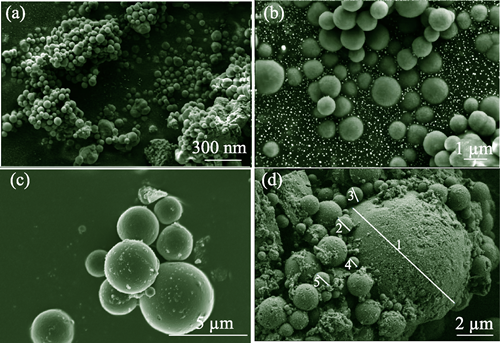
|
|
|
Influence of RE-Si-Al-O Glass Phase on Microstructure and CMAS Corrosion Resistance of High Entropy Rare Earth Disilicates
LI Liuyuan, HUANG Kaiming, ZHAO Xiuyi, LIU Huichao, WANG Chao
2024 Vol. 39 (7): 793–802
 Abstract
Abstract(
145 )
 HTML
HTML(
8)
 PDF
PDF(10967KB)(
167
)
Environmental barrier coating (EBC) is a key material for high power-to-weight ratio aero engine, which can provide effective protection for the hot end components of ceramic matrix composites, and prevent the erosion of gas and environmental corrosive media. At present, high entropy rare earth disilicates ((xRE1/x)2Si2O7) are the most promising next-generation environmental barrier coatings. In order to enhance the CMAS corrosion resistance of high entropy rare earth disilicates, a novel high entropy (Y0.25Yb0.25Er0.25Tm0.25)2Si2O7/RE-Si-Al-O (RE=Yb, Y, and La) multiphase ceramic was designed and prepared. The results show that the RE-Si-Al-O glass phase can not only wrap the ceramic grains, but also exist at the grain boundaries. Moreover, this multiphase ceramics can promote the growth of rare earth disilicate grains, reduce the number of grain boundaries, and decrease the number of diffusion channel of CMAS melt. As the radius of rare earth ion in the RE-Si-Al-O glass phase increases, the glass phase is more prone to react with Ca2+ ion in the CMAS melt, generating apatite, reducing the activity of the CMAS melt, inhibiting the erosion of high entropy rare earth disilicate grains by the CMAS molten salt, and thus improving the CMAS corrosion resistance of high entropy rare earth disilicates. After corrosion at 1500 ℃ for 48 h, there is still a residual CMAS layer on the surface of (Y0.25Yb0.25Er0.25Tm0.25)2Si2O7/La-Si-Al-O multiphase ceramics, indicating that the multiphase ceramics have good resistance to CMAS corrosion. In conclusion, the microstructure design of this multiphase ceramic provides a new approach to improve the long-term application of EBC materials in high-temperature CMAS environments.
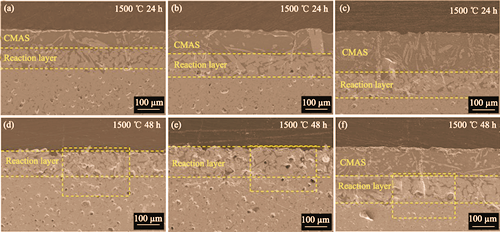
|
|
|
Anticorrosion Performance of 8YSZ Ceramics in Simulated Aqueous Environment of Pressurized Water Reactor
FAN Wugang, CAO Xiong, ZHOU Xiang, LI Ling, ZHAO Guannan, ZHANG Zhaoquan
2024 Vol. 39 (7): 803–809
 Abstract
Abstract(
171 )
 HTML
HTML(
7)
 PDF
PDF(1438KB)(
190
)
8% (molar fraction) Y2O3 stabilized ZrO2 (8YSZ) ceramics have important applications in fuel cells, thermal barrier coatings, as well as thermal insulation due to their excellent oxygen ionic conductivity and low thermal conductivity. However, their corrosion resistance to water and their behaviors as thermal insulation or structural material in pressurized water reactors during accidents are not fully understood. This study systematically examined the mass, crystal phase, microstructure, mechanical properties, and solution composition of 8YSZ ceramics over time in a dynamic water environment at 350 ℃/17.4 MPa with 0.3 μg/L dissolved oxygen, aiming to simulate a pressurized water reactor environment. It is found that the mass of 8YSZ ceramics increases firstly and then decreases with corrosion duration time. The mass change is influenced by the surface roughness. The weight gain is attributed to the formation of Zr-OH and Y-OH clusters by the entry of water molecules into the ceramics, whereas the weight loss is caused by the metal cations leaching and the dissolution of grains. Phase analysis demonstrates that the cubic 8YSZ after corrosion does not undergo any phase transformation towards tetragonal or monoclinic phases, which is different from the degradation mechanism of tetragonal or partially stabilized zirconia. Changes in surface and cross-section morphology indicate that water molecules enter the interior of the ceramics along defects or microcracks, producing grain boundary damage and changing the fracture mode in the corrosion-affected region from transgranular to intergranular fracture. Compressive and flexural strengths of this ceramics after corrosion do not change significantly, while the Vicker’s hardness decreases slightly, which are related to the formation of pits in the surface layer. As a consequence, depth of the corrosion pit after 1050 h is only 30.8 μm, and the mass change rate of per unit surface area is -0.108×10-3 mg∙cm-2∙h-1, consolidating excellent water corrosion resistance of 8YSZ ceramic. Therefore, 8YSZ ceramics are promising for thermal insulation or structural materials in pressurized water reactors.

|
|
|
Boost Electrochemical Reduction of CO2 to Formate Using a Self-supporting Bi@Cu Nanotree Electrode
SHI Tong, GAN Qiaowei, LIU Dong, ZHANG Ying, FENG Hao, LI Qiang
2024 Vol. 39 (7): 810–818
 Abstract
Abstract(
215 )
 HTML
HTML(
13)
 PDF
PDF(4925KB)(
208
)
Electrochemical reduction of CO2 to high value-added hydrocarbon fuels and chemicals has emerged as an effective strategy to achieve carbon neutrality. In conventional electrocatalytic powder-coated electrodes fabricated by spraying method, poor contact between electrocatalyst and substrate can severely impact the electrocatalytic activity and stability. Herein, a self-supporting nanotree electrode (Bi@Cu NTs) for efficient electroreduction from CO2 to formate was structured by combing facile electrodeposition method and galvanic replacement reaction. The advantages of self-supporting nanotree structure including: 1) minimization of the interfacial resistance and improvement of the spatial structure stability; 2) rich active sites and plentiful pore structures. The charge transfer resistant could be effectively reduced while ensuring the stability of the electrode operation. Results demonstrated that the prepared Bi@Cu NTs electrode exhibited outstanding performance for CO2 conversion in both electrochemical activity and long-term operation stability. In a wide operating potential window from -1.4 to -0.8 V (vs. RHE), the proposed Bi@Cu NTs electrode presented excellent formate selectivity, where the Faradaic efficiency of CO2-to-formate (FEFormate) at each operating potential was above 90%. Typically, at -1.2 V, the proposed electrode achieved a high FEFormate of 97.9% and a current density of 170.6 mA·cm-2, simultaneously. Meanwhile, the self-supporting Bi@Cu NTs electrode also revealed excellent stability in a long-term operation, as evidenced by maintaining an average FEFormate of more than 90% and an average current density higher than 110 mA·cm-2 over 50 h of continuous electrolysis at a controlled potential of -1.0 V without any degradation in performance.
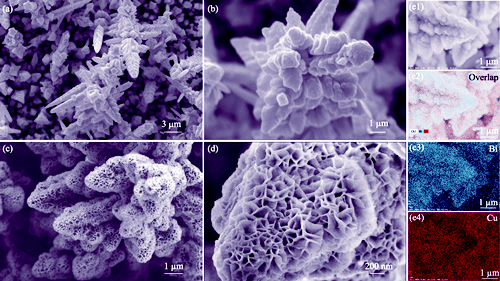
|
|
|
Preparation and Performances of Tubular Cone-shaped Anode-supported Segmented-in-series Direct Carbon Solid Oxide Fuel Cell
YE Zibin, ZOU Gaochang, WU Qiwen, YAN Xiaomin, ZHOU Mingyang, LIU Jiang
2024 Vol. 39 (7): 819–827
 Abstract
Abstract(
151 )
 HTML
HTML(
2)
 PDF
PDF(6291KB)(
214
)
To solve the problem of large concentration polarization impedance of anode-supported direct carbon solid oxide fuel cell (DC-SOFC), tubular cone-shaped anode-supported segmented-in-series solid oxide fuel cell (SOFC) was prepared by an improved gel-casting method. By appropriately increasing content of the solvent, fluidity of the slurry and quality of the obtained product were improved. By increasing content of the pore-forming agent, the porosity of the anode was increased, reducing the diffusion resistance of gas. As-improved SOFC was fueled by hydrogen and operated at 800 ℃ with an open-circuit voltage of 1.05 V. The polarization impedance of the electrochemical impedance spectrum decreased while the maximum power density was 0.67 W•cm-2 and the active area of the cathode was 2.2 cm2. These SOFC electrochemical performances were significantly higher than that before improvement. Activated carbon loaded on the anode with 5% (in mass) K as catalyst was directedly used as the fuel of SOFCs. Using this anode-supported direct carbon, the DC-SOFC was prepared, showing an open circuit voltage of 1.030 V and a peak power density of 0.74 W•cm-2 at 800 ℃. This DC-SOFC was discharged at a constant current of 400 mA, and its effective utilization rate of carbon fuel was 31% which was higher than that before improvement (17%). Four improved tubular cone-shaped single cells were connected in series to form a four-cell stack, showing a peak power of 8.0 W and a corresponding power density of 0.91 W•cm-2 at 800 ℃, which was higher than that before improvement (4.1 W), exceeding the maximum of previous reported DC-SOFC, and displayed an effective utilization rate of 15% for carbon fuel.
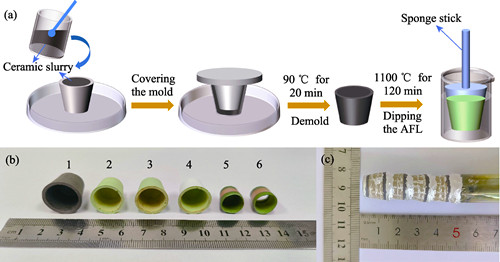
|
|
|
Nanofiber-modified Electron Transport Layer for Perovskite Solar Cells
XIAO Zichen, HE Shihao, QIU Chengyuan, DENG Pan, ZHANG Wei, DAI Weideren, GOU Yanzhuo, LI Jinhua, YOU Jun, WANG Xianbao, LIN Liangyou
2024 Vol. 39 (7): 828–834
 Abstract
Abstract(
166 )
 HTML
HTML(
6)
 PDF
PDF(5516KB)(
249
)
Tin dioxide (SnO2) is widely used in perovskite solar cell (PSC) as an electron transport material due to its high transmittance, high electron mobility, good UV stability, and low-temperature processing. However, SnO2 electron transport layer prepared from commercial colloidal solution still faces some challenges such as easy agglomeration, defects, and energy level mismatch, limiting its performance and stability. This study improved the quality of SnO2 films by introducing a polymer chitin nanofiber (1,2-dibenzoyloxyphenylchitin, DC) into the SnO2 precursor solution, and systematically studied the effect of DC on the precursor solution, film and device performance. Experimental results showed that DC additive could effectively inhibit the agglomeration of SnO2 nanoparticles, ensuring a more homogeneous dispersion in the precursor solution. The improved SnO2 films had smaller roughness and could be better wetted by perovskite solution, which is beneficial to closer contact with the perovskite layer. Simultaneously, the oxygen vacancy defects in the SnO2 films were effectively passivated, and the proportion of defects was reduced to 30%, further improving the quality of the films. Based on the improved energy level matching between the SnO2 electron transport layer and the perovskite layer, the carrier extraction and transport performance was optimized. The performance of DC-modified PSC was significantly improved, and the photoelectric conversion efficiency of the optimal device reached 19.11%. This work not only overcomes the agglomeration problem of the SnO2 electron transport layer during the preparation process, but also provides theoretical guidance and method for improving the performance of perovskite solar cells.
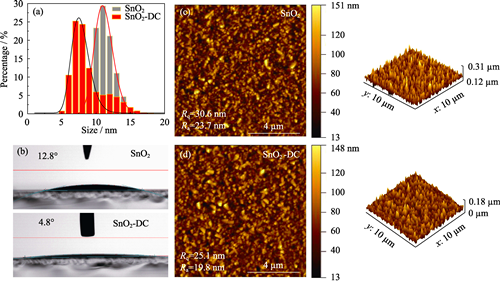
|
|
|
Transition Metal-doped Manganese Oxide: Synthesis by Warm Plasma and Electrocatalytic Performance for Oxygen Evolution Reaction
LI Jiaqi, LI Xiaosong, LI Xuanhe, ZHU Xiaobing, ZHU Aimin
2024 Vol. 39 (7): 835–844
 Abstract
Abstract(
145 )
 HTML
HTML(
3)
 PDF
PDF(2346KB)(
193
)
By using renewable electricity proton exchange membrane (PEM), water electrolysis can produce “green hydrogen” of which the rate-determining step is oxygen evolution reaction. Considering the problems of stability, activity and cost, manganese oxides (MnOx) doped with transition metals as a kind of electrocatalysts (Fe-MnOx, Co-MnOx, and Ni-MnOx) were directly synthesized in one-step by gliding arc warm plasma. Complementary characterizations of the crystal structure, morphology, element composition, and surface valence state on this kind of synthetic catalysts were conducted. The results show that MnOx mostly consists of crystalline Mn2O3 and amorphous Mn3O4. Although the transition metal doped catalysts possess the very approximate crystalline compositions to MnOx, they showed a remarkable decrease in particle size and an increase in specific surface area are achieved. Introducing Co to form Co-MnOx can increase surface density of electrons as compared to pure MnOx. We further reveal a unique current step of MnOx-based catalysts in acidic medium which appears in three consecutive potential regions (low I: 1.4-1.8 V, low II: 1.8-2.4 V, and high III: 2.4-2.7 V) under cyclic voltammetry (CV) measurements. This current step process is quite consistent with the electrode dynamics curve (as reference) which is reduced by a simplified version of Bulter-Volmer equation, during which the electrocatalytic behavior involves manganese at multi-valence states. At low potential regions Fe-MnOx achieves the highest activity among all catalysts, while at high potential region only Co-MnOx achieves. Furthermore, Co-MnOx onset potential is 160 mV lower than that of pure MnOx, and three times of the ending current density of pure MnOx during bulk electrolysis under potentiostat. Consistent with the trend in activity, at low potential regions Fe-MnOx is the most stable, while at high potential region Co-MnOx is. Consequently, the significant increase in oxygen evolution reaction activity and stability of manganese oxides doped with transition metals is attributed to transition metal doping, which obviously optimizes the particle size, specific surface area, and electronic structure of MnOx.
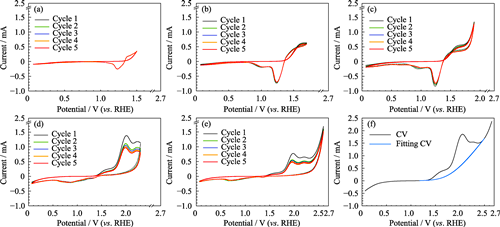
|
|
|
First-principles Investigation of Single 3d Transition Metals Doping Graphene Vacancies for CO2 Electroreduction
JIN Yuxiang, SONG Erhong, ZHU Yongfu
2024 Vol. 39 (7): 845–852
 Abstract
Abstract(
220 )
 HTML
HTML(
5)
 PDF
PDF(6050KB)(
136
)
Among all options of carbon neutrality, conversion of CO2 into valuable chemicals by electrocatalytic reduction exhibit outstanding performance. However, due to the numerous products and complex pathways of CO2 electrocatalytic reduction, the exact factors affecting the activity of CO2 electrocatalytic reduction have not yet been identified. In addition, the CO2 electrocatalytic reduction process is often accompanied by hydrogen evolution reaction (HER). Therefore, it is still challenging to design a catalyst with high selectivity and high activity for specific product. Herein, this study systematically investigated the potential of 3d transition metal-based single-atom catalysts (SACs) positioned at graphene single vacancies (TM@CSV), as well as double vacancies (TM@CDV), for the CO2 reduction reaction (CO2RR) using first-principles. The exploration encompassed substrate stability, CO2 adsorption, and the HER as the main competing reaction. Through the careful screening of 20 catalysts formed by Sc, Ti, V, Cr, Mn, Fe, Co, Ni, Cu and Zn doped graphene defects, several promising catalysts were identified: Sc@CSV situated on graphene single vacancies, Sc@CDV and Ti@CDV situated on graphene double vacancies. They could not only effectively adsorb CO2 molecules, but also inhibit HER, the main competing reaction. In assessing their performance in CO2RR, all exhibited selectivity toward HCOOH. Notably, Sc@CDV demonstrated the best selectivity, requiring the lowest ΔG (0.96 eV) for efficient CO2 conversion to HCOOH. Electronic structure analysis revealed that Sc@CDV outperforms due to its optimal balance between ΔG of hydrogenation and the product desorption achieved through a moderate number of active electrons.
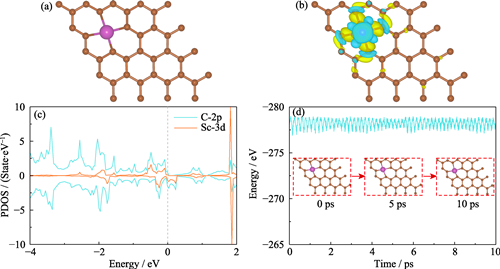
|
|